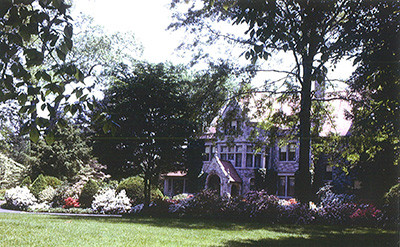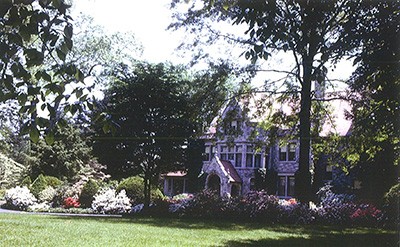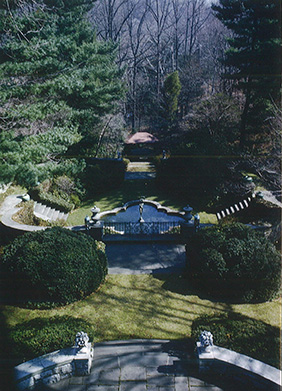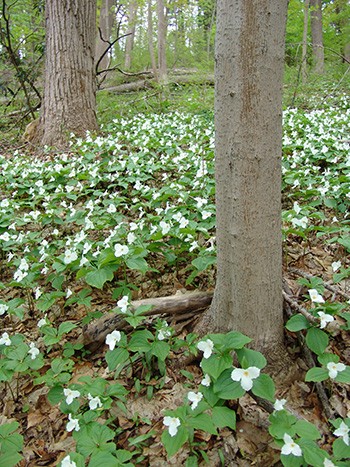
Off the Beaten Path: History of the Crum Ruins
Guest Author: Marissa Lariviere ‘18
Have you ever stumbled across the strange ruins in the Crum Woods? At first glance, these crumbling walls just seem creepy. But don’t run away- this area actually has a long and fascinating history, involving magnificent mansions and dating all the way back to Pennsylvania’s founder, William Penn.

In 1927, Lytlecote was bought by Ward Hinkson and his wife Edith, and renamed Oak Knoll. The Hinksons would go on to construct an elaborate estate over the 32 acres, turning their home into an iconic site in the area. photo credit: Scott Arboretum Archives
Lytlecote
The estate was originally one of three parcels purchased from William Penn in 1681 by a Society of Friends member, Thomas Powell. Centuries later, in 1892, Mrs. James H. Little bought the estate and named it Lytlecote. She built an elite suburban fieldstone mansion on the former farmland, which was described by a contemporary as “one of the most attractive of the many handsome Delaware county estates… massive in its proportions and beautiful in its surroundings.”

A view of the Italian Water Garden from the house. These are the ruins you can find along the trail today. photo credit: Scott Arboretum Archives
Oak Knoll
In 1927, Lytlecote was bought by Ward Hinkson and his wife Edith, and renamed Oak Knoll. The Hinksons would go on to construct an elaborate estate over the 32 acres, turning their home into an iconic site in the area. This included a swimming pool, a private arboretum, and an Italian Water Garden complete with a fountain. In their gardens, the Hinksons and their six gardeners cultivated boxwood hedges, roses, tree peonies, rhododendrons, and Exbury azaleas, among others. They also planted an abundance of trees, including Norway spruces, white pines, a double-flowering dogwood, golden-flowered fringe trees, a lace leaf maple, and flowering cherry trees. Five greenhouses stood near the house, where the Hinksons grew twelve varieties of orchids commercially. Around 100,000 of these orchid flowers were cut and sold each year.

Five greenhouses stood near the house, where the Hinksons grew twelve varieties of orchids commercially. Around 100,000 of these orchid flowers were cut and sold each year. photo credit: Scott Arboretum Archives
In 1964, the Hinksons sold much of their land to be turned into suburban homes. However, the real demise of Oak Knoll came with the construction of the Blue Route Highway (Interstate 476). The estate was demolished to clear the path for the new road. In preparation, all 73,000 of the Hinksons’ orchids were sold at auction and their greenhouses were dismantled. By 1967, the Hinksons had moved to a new home in Upper Providence and construction of the Blue Route began. The highway would be completed in 1992.

The trillium that cover the banks of the Crum Woods in the spring are remnants of the Oak Knoll estate. photo credit: R. Robert
Crum Ruins
Today, little remains of the Hinkson’s elaborate estate. However, the ruins of Oak Knoll’s Italian Water Garden can still be found in the Crum Woods. They are now known as “the Crum Ruins,” “the sunken gardens,” or simply “the ruins.” The ruins consist of the stone walls and steps of the water garden, whose stonework is weathered but not seriously damaged. The college has filled in the small central pool with soil to avoid liability. These ruins are a popular destination for hikers, joggers, and bikers on the Leiper-Smedley trail. This paved path, which is over two miles long, runs from the Thomas Leiper House to Smedley Park. Visitors can still see many of the plants that were cultivated at Oak Knoll, including flowering cherries, yews, white pines, a sourwood, a cucumber magnolia, Japanese pachysandra, large-flowered, sessile, and yellow trilliums, and an abundant akebia vine. These ruins are an important part of local history in a beautiful natural setting. For the adventurous hiker, they’re definitely well worth a visit!
_________________________________________________________________________________________________
This article is part of an ongoing column called the Crum Woods Chronicle. The Crum Woods Chronicle will be periodic updates and observations about subjects related to natural history, interesting species found in and around the Crum Woods, and exciting events you can get involved in. My hope is that some of these topics will interest you, strengthen your connection to the Crum Woods, and inspire you to explore your backyard a little more often.
Natural areas do not maintain their character and quality independently, especially when they are heavily used by people and embedded in urban environments. Educating yourself about aspects of the Crum Woods that interest you and understanding how your individual use of the Crum Woods impacts it (and how you can reduce that impact!) are important steps every one of us should take.
“In the end we will conserve only what we love; we will love only what we understand; and we will understand only what we are taught.” –Baba Dioum






Lynn Etheredge
Posted at 12:52h, 30 JuneMarissa – is there an on-line map showing where the ruins are?
Thanks. Lynn ’68
Becky Robert
Posted at 08:39h, 11 JulyDear Lynn,
Unfortunately, the ruins are not shown on the trail maps. They are located off of the Leiper-Smedley Trail walking from the Avondale Road access point.
Sincerely,
Becky Robert
Scott Arboretum
Andrew
Posted at 04:59h, 12 JulyYou can just barely make them out on Google maps. Draw a line due west from the north end of the Swarthmore College track. Zoom in on the edge of the woods before the Leiper trail and 476.
Becky Robert
Posted at 08:53h, 12 JulyThanks Andrew. I didn’t think about looking at google.
Sincerely,
Becky Robert
Scott Arboretum
Andrew
Posted at 19:53h, 12 JulyThere used to be two brick pits (possible cisterns?) along a disused high path near the Sunken Gardens heading toward the trestle. One had been filled up but the fill had settled a few feet but the other was a 9′ deep, 7′ round chamber with a domed ceiling and manhole sized opening.
Very mysterious and dangerous, I always wondered what they were for.
Joe Mccarty
Posted at 05:29h, 13 SeptemberIf you’re heading towards Springfield away from Chester on Providence Road right before you go over that long bridge and the car dealership is directly on the other side you Veer right. Take that all the way down to the stop sign it’ll be under the overpasses. Park and that’s the beginning of the trail go 150 yards up the trail which is not far at all and to your right you’ll see the ruins you can’t miss it
J
Posted at 15:16h, 26 SeptemberI was under the impression that it is still private property, as is the existing house, driveway, and field thereby.
Becky Robert
Posted at 15:24h, 26 SeptemberThe ruins are in the woods along the trail. The entire property is owned by the College and thus private property. The trails are open for visitors to hike but the field which holds our compost, nursery, and other equipment is not along with intact home at the top of the driveway (also part of college property). The ruins can be accessed off of the Leiper trail and are not accessible by vehicle. I hope this helps.
Sincerely,
Becky Robert
Scott Arboretum
Darina
Posted at 00:33h, 12 MarchPlanning to visit this place tomorrow!
Darina Evstafeva
Posted at 00:39h, 13 MarchHave been there today. Anyone knows when is the garden was built?
Becky Robert
Posted at 07:47h, 15 MarchIn 1927, Lytlecote was bought by Ward Hinkson and his wife Edith, and renamed Oak Knoll. The Hinksons would go on to construct an elaborate estate over the 32 acres, turning their home into an iconic site in the area.
Carol Bauder
Posted at 23:53h, 23 MarchI used to play in those woods as a child!! Me and many of my friends!!
Wonderful memories!
There were alot of ruins there at the time, however I moved away at the age of 13 many years ago and have not been back and have been told it has all changed greatly! That’s sad to me..
It was so beautiful left untouched back in the day!
I will get a chance soon to come take a look hopefully still can get a peak at what’s left!